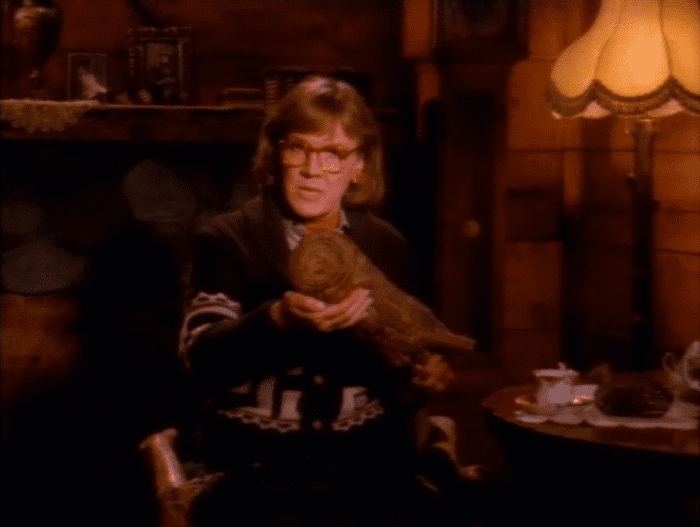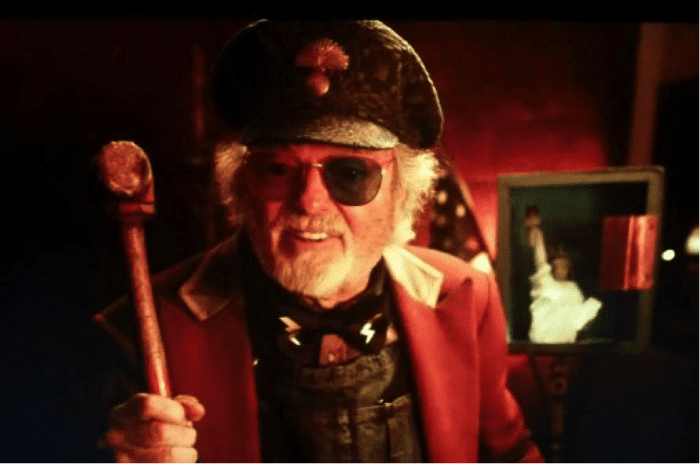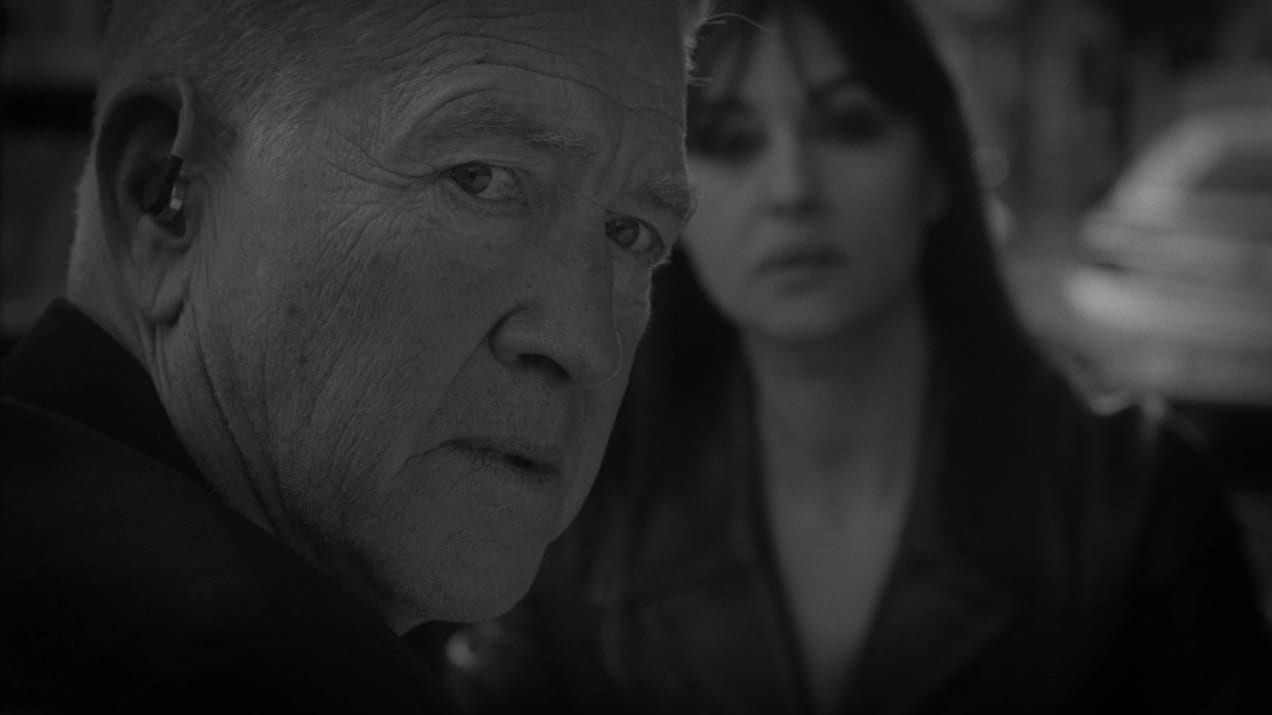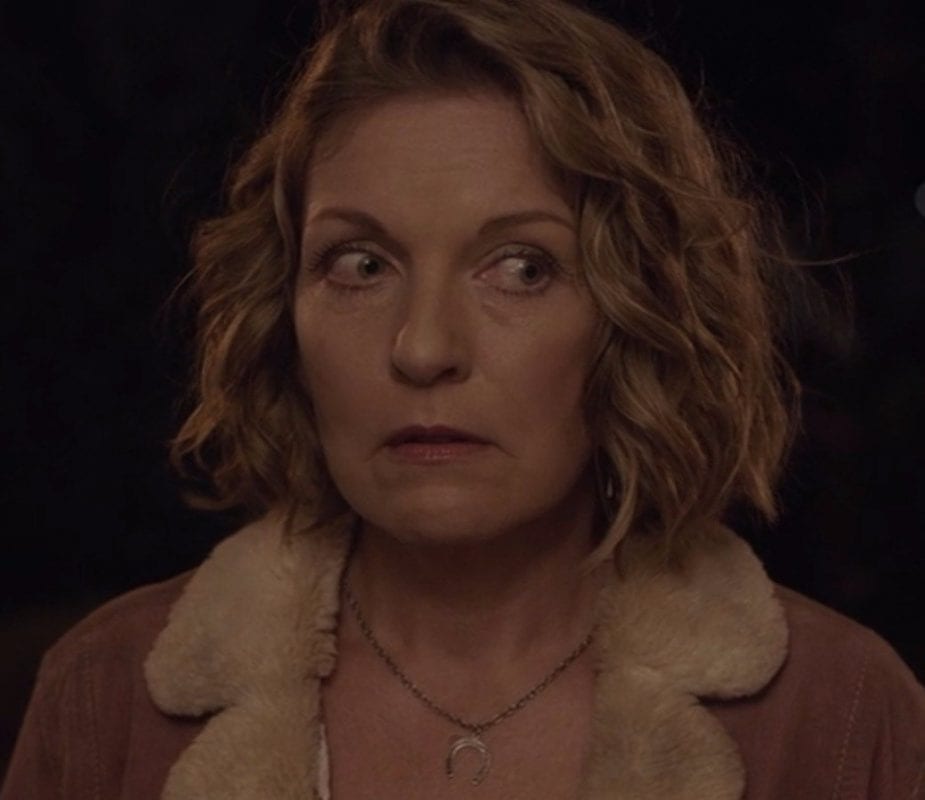The following is a guest post by Allisandra diCampo-Cohn.
Laura Is the One
It is clear that Laura is the One, because as the Mistress of the Waiting Room—The Golden Orb—she is the one who sees us, the viewer, and our actions in all Twin Peaks timelines. She also has power over us. She is hyper-aware that we bear some responsibility for her never-ending nightmare. As Carrie Page, she tried to hide from us and our gift of garmonbozia. Cooper found her, and so did we. This essay will argue that she and others are actively aware of us: We are the Primum Mobile in the Twin Peaks universe. We are the key to ending her nightmare. But first, let’s talk a little about dreams.
Dreams in Theory
The study of dreams is called oneirology. It deals with the ideas, emotions, and sensations we experience during sleep. A few interesting facts about dreams:
- They occur only during the REM phase of sleep, and the length and amount of our dreams do not vary from night to night.
- Brain activity while sleeping is highest during dreams.
- Teens and young adults dream more than the rest of us (not surprising, then, that the teens in Twin Peaks are dreaming so much).
- The dreams of people blind from birth consist of experiences of the other senses: hearing, touch, smell, and taste.
- The most common emotion in dreams is anxiety.
- About 24% of humans dream in black and white.
Dreams allow us to confront emotions and beliefs we can’t confront while awake. Thus, we have more power while we dream. Freud taught that dreams reveal hidden desires. Jung taught that dreams are messages and that different types of dreams, such as recurring dreams, present to us different ways of working through problems.[1]
Dream in History and Culture
Human beings have always valued dreams. From the ancient Greeks to the major Abrahamic religions, historically dreams have always been held as an important part of our existence.[2] In Twin Peaks, the Japanese Shinto sect of Buddhism plays a major role. Shinto is “the traditional religion of Japan that focuses on ritual practices to be carried out diligently to establish a connection between present-day Japan and its ancient past.”[3] Kami, the myriad of Shinto gods, refers particularly to the power of phenomena that inspire a sense of wonder and awe in the beholder—the sacred? The Dreamer—testifying to the divinity of such a phenomenon. Kami have the power of Mukoku—dream revelation—which allows them to appear in dreams to communicate their will. Also, Kami can reside in natural things such as mountains, wind, trees, and waterfalls. Twin Peaks fans are well aware of the power of nature in Lynch’s work (e.g., ominous whooshing). Lynch is our Kami, revealing his will to us through dreams.[4]
Who Is Aware of Us, the Viewer?
There are four characters who are specifically aware of the viewer. Their actions and messages are meant deliberately and directly for us. They speak, act, or look directly at us. These characters are trying to tell us, the viewers, that we are in a dream, and they are warning us to hurry up and wake up.
1. The Log Lady

The Log Lady introductions are monologues written by David Lynch to introduce each chapter of Seasons 1 and 2. Margaret Lanterman knows us intimately. She looks directly at us. She shares her advice, shining her lantern on us, warning us—the viewers—that we are the dreamers of suffering and pain.
All that we see in this world is based on someone’s ideas. Some ideas are destructive, some are constructive. Some ideas can arrive in the form of a dream. I can say it again: some ideas arrive in the form of a dream.
Season 1, Episode 4[5]
Look in the mirror. What do you see? Is it a dream, or a nightmare? In a dream, are all the characters really you? Different aspects of you? Do answers come in dreams?…I am filled with questions. Sometimes my questions are answered. In my heart, I can tell the answer is correct. I am my own judge. In a dream, are all the characters really you? I am filled with questions. Sometimes my questions are answered. In my heart, I can tell the answer is correct. I am my own judge. In a dream, are all the characters really you? Different aspects of you? Do answers come in dreams?
Season 1, Episode 8
As the night wind blows, the boughs move to and fro; the rustling, the magic rustling that brings on the dark dream. The dream of suffering and pain: pain for the victim, pain for the inflicter of pain—a circle of pain, a circle of suffering.
Season 1, Episode 14
Margaret implores us to wake up, begging us to realize that we have some control over the dream. She asks us, the viewers, if our dream will form ideas, answers, or darkness in a circle of pain—the pain we inflict on Laura.
2. Dr. Amp/Jacoby

Now for our favorite incarnate id, Dr. Amp. Jacoby as id is “the critical and moralizing role; the realistic part that mediates between the desires of the id and the super-ego.”[6]
Opening the first scene of Twin Peaks: The Return that occurs in the real-time present with our favorite shrink, Jacoby, seemed odd and out of place. He was never a core character like Audrey or Mike. And I believe his usefulness as a character was depleted in Season 2. Also, Dr. Amp never uses the word dream. Yet here he is on the Good Mountaintop, White Tail Mountain, screaming at the world, ordering us to do something. Initially he seems to be like Rush Limbaugh or Sean Hannity. But why is he put in such a lofty first scene? Dr. Amp follows the initial Cooper White Lodge scene because, unlike the Giant’s instructions to Cooper, Amp’s instructions are to us, the viewer. It’s also a simple message:
AMP (RINGING HIS BELL):
You must see, hear, understand and act now! Shovel your way out of the shit![7]
Season 3, Episode 5
Dr. Amp does not recognize us, but that’s immaterial, as he is screaming in the dark to everyone in the world—including us. By yelling at us, he is trying to tell us to wake up. Keep in mind that Jacoby is the only person who knows of the Black Lodge and that Laura was there, but he has never been there. Remember the cassettes from Season 1, Episode 1?
We hear background noises on the tape; ambient sound from a department store.
LAURA’S VOICE (CONTINUED)
“…and as you probably already noticed, I’m gonna mail it to you in the ugly little plain envelope you gave me…for, what was the word you used? “confidentiality’s sake’…this is kind of fun…first, you’re always bugging me to tell you what my dreams are—let me tell you about this one I had last night: it was a doozy…”
He reaches into his desk and takes out a pair of headphones, which he puts on.
LAURA’S VOICE (CONTINUED)
“I was in this strange room and there was this little man and this other older man I’d never seen before either, but they both seemed to know me…there was music…and I was telling all my secrets to the older man…”
He plugs the headphones in and we no longer hear her voice. As he listens and chomps on the milkballs, his face registers a whole gamut of emotions.
Season 1, Episode 1
3. Monica Bellucci

Gordon’s black and white dream scene with Monica Bellucci and Melita Toscan du Plantier is otherworldly. Obviously, its purpose is to get Gordon to remember a pivotal scene from Fire Walk With Me. But how are we, the viewer, there? I see a clue in an empty space and a slow eye blink:
GORDON:
“And last night, I had another Monica Bellucci dream…in Paris on a case. Monica called and asked me to meet her at a certain cafe. She said she needed to talk to me. When we met at the cafe, Cooper was there, but I couldn’t see his face. Monica was very pleasant. She had brought friends.”
Note there is an empty space with a water glass across from Melita Toscan du Plantier to the right of Gordon. I believe this space, sans chair, is for the Viewer.
GORDON:
We all had a coffee.
Monica slowly blinks her eyes then looks at Gordon.
GORDON:
And then she said the ancient phrase…
MONICA:
We’re like the dreamer, who dreams and then lives inside the dream.
This is directed to Gordon. The slow blink is used throughout Twin Peaks, but it most especially stands out with Bellucci and Laura Palmer. I believe it is an indicator of changed states—dream to dream, time to time—and changed focus to a new audience.
GORDON:
…who dreams and then lives inside the dream.
GORDON:
I told her I understood. And then she said…
MONICA:
But who is the dreamer?
Here, she leans in. Monica is speaking to the viewer. This shot in which Monica’s face fills the screen is not an overhead shot indicating the back and forth with Gordon. It’s her close-up face looking directly at us, the viewer:
GORDON:
But…[shot held on Monica’s leaned in face]…who is the dreamer? A very powerful, uneasy feeling came over me. Monica looked past me and indicated to me to look back at something that was happening there. I turned and looked. I saw myself. I saw myself from long ago, in the old Philadelphia.
4. Laura Palmer

Finally, and most importantly, there is Laura Palmer. We are like the faithful diary whom the writer trusts wholeheartedly.
Dear Diary: My name is Laura Palmer, and as of just three short minutes ago, I officially turned twelve years old! It is July 22, 1984, and I have had such a good day! You were the last gift I opened and I could hardly wait to come upstairs and start to tell you all about myself and my family. You shall be the one I confide in the most. I promise to tell you everything that happens, everything I feel, everything I desire. And, every single thing I think. There are some things I can’t tell anyone. I promise to tell these things to you.[8]
And as she did with her family and friends, and Agent Cooper, she confides all her secrets to us, and yet we let her down.
Laura and Cooper are on Tremond porch (Season 3, Episode 18, 1:50:15:15). Laura looks at Mrs. Tremond. She then notices us, the dreamer. She holds that stare at us.
She looks at Cooper. Then she looks at us. She sees the viewer. And when she screams in the final scream, she is waking the viewer up. We are the dreamer. So is Cooper. So is Laura. We are all participants in the shared dream. We must work together to reveal the ideas and wake up.
This is perfectly clarified as Laura and Cooper are on the former (ever?) Palmer house porch. Cooper and Alice are speaking. There are slow questions back and forth. They are not paying any attention at all to our Laura, though Laura and we, the viewer, are what this scene is all about. She realizes we are here, as she awakes from her Carrie Page gaze on the now Tremond front porch. She looks at Cooper as he asks Alice questions and receives answers that she cannot comprehend. As she wakes from the fog, she looks at Alice. Then she sees the viewer—us. She’s confused and looks at the ground, trying to understand. Then she looks at Cooper, then Alice again, and as Coop asks Tremond, “Do you rent this house?” (01:51:00.12), Laura, no longer missing Carrie, opens her eyes wide and holds her horrified gaze on us. At this point, Laura looks away from us and slowly turns to Cooper—and it’s a look of disgust, of suspicion, of recognition (01:52:21.15 through to door close).
We know Laura recognizes us. Laura—who was martyred in a life of dream rapes, dream portals, dream angels; who was taken away from us in body due to Cooper’s actions in Episodes 17 and 18 of Season 3—disappears and is wrenched into the heavens, nullified. She acts in our dreams. It is she who must wake us up—to save herself!
When she hears Cooper ask, “What year is this?” and hears echoes of Sarah Palmer attempting to control her yet again with “Laura? Laura!,” she knows she must end the infinite circle. Laura, with that blood-curdling scream, yells at the viewer, at Cooper, at herself: “It’s finished! Wake up!”
The Viewer Completes the Art
Finally, I leave you with a quote from 20th-century artist Marcel Duchamp:
All in all, the creative act is not performed by the artist alone; the spectator brings the work in contact with the external world by deciphering and interpreting its inner qualification and thus adds his contribution to the creative act. This becomes even more obvious when posterity gives a final verdict and sometimes rehabilitates forgotten artists.[9]
David Lynch, living the Art Life, recognizes that the viewer’s interpretation of art is an important contribution to the work of art itself. Thus, by showing these people talking to us, the dreamer, we respond to those entreaties. Like looking at a painting and noticing a small yet significant brushstroke, we contribute to that piece of art. Thus, the viewer being the dreamer is our contribution to Twin Peaks.
Dear viewer, dear me: drink your coffee and wake up!
Allisandra diCampo-Cohn loves criticism. Contact allie via Twitter @amarikidd. Thank you to all the lovely Twitter #TwinPeaks community, which inspires me with hope and love all the time. Especially to my husband, who edited this article despite the fact that Twin Peaks makes his eyes glaze over.
[1] Wikipedia, “Dreams,” https://en.wikipedia.org/wiki/Dream.
[2] Morpheus was the ancient Greek god of dreams. He sent all sorts of things into people’s dreams, specifically, entities that appeared human. See Encyclopedia Brittanica, “Morpheus,” https://www.britannica.com/topic/Morpheus-Greek-mythology.
The Kabbalists explain that while we sleep, our souls leave our bodies and ascend to their heavenly source to replenish their energy. In this disembodied state, the soul is free to experience visions and encounters that are usually off-limits to beings of this world. This includes the possibility of meeting other disembodied souls—particularly the souls of loved ones who have passed away. It is their opportunity to convey a message to those they have left behind. See Aron Moss, “What Do Dreams Mean?,” Chabad.org, https://www.chabad.org/library/article_cdo/aid/274823/jewish/What-Do-Dreams-Mean.htm.
[3] Wikipedia, “Shinto,” https://en.wikipedia.org/wiki/Shinto.
[4] Encyclopedia of Shinto, “Kamigakari, Takusen,” http://eos.kokugakuin.ac.jp/modules/xwords/entry.php?entryID=1308.
[5] All quotations from Season 1 are taken from “Twin Peaks: Season 1,” Lynch/Frost Productions, ABC Television Productions, 1990-1991.
[6] Wikipedia, “Id, Ego and Super-Ego,” https://en.wikipedia.org/wiki/Id,_ego_and_super-ego#Id.
[7] All quotations from Season 3 are taken from “Twin Peaks: The Return,” Showtime and Rancho Rosa Productions, Lynch/Frost Productions, 2017.
[8] Jennifer Lynch, The Secret Diary of Laura Palmer (New York: Gallery Books, 2011).
[9] Marcel Duchamp, quoted in Maria Popova, “The Creative Act: Marcel Duchamp’s 1957 Classic, Read by the Artist Himself,” BrainPickings.org, https://www.brainpickings.org/2012/08/23/the-creative-act-marcel-duchamp-1957/.





I like it, very interesting concept. Now let me go back and view those scenes again that you mention. 🙂
Not to nitpick, but the two instances of ‘id’ I placed in {brackets} below really should be changed to [ego] as our ego is the mediating force between the primal desires of our id and the learned social mores that define our moral value systems in social contracts represented by the superego.
Now for our favorite incarnate {id}, Dr. Amp. Jacoby as {id} is “the critical and moralizing role; the realistic part that mediates between the desires of the id and the super-ego.”[6]
So, a fixed version will be stated like this:
Now for our favorite incarnate [ego] , Dr. Amp. Jacoby as [ego] is “the critical and moralizing role; the realistic part that mediates between the desires of the id and the super-ego.”[6]
Hello people,
I hope you are well and great
I’m researching the Dream interpretation web site. And I’m going to see your site. Thank you for providing the best interpretative
Keep up the great work, it’s hard to find good ones. I added to my favorites.
Thank you very much.
I love this Allie. So interesting overall, and the way you describe our participation makes me a little emotional. Well done!
Mike looks directly at the camera as he says “and the damned” in the original series. He is talking about who can see Bob. The gifted, and the damned.
Good article
thanks for share like this article
Keep up the great work, it’s hard to find good ones. I added to my favorites.
thanks for share this kind of information.